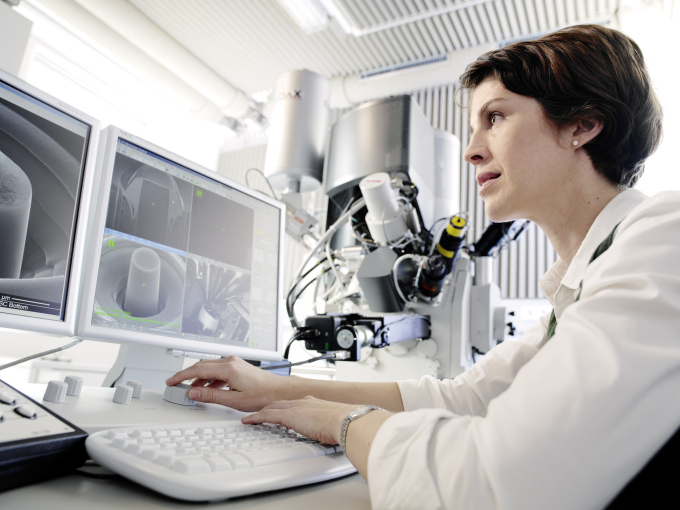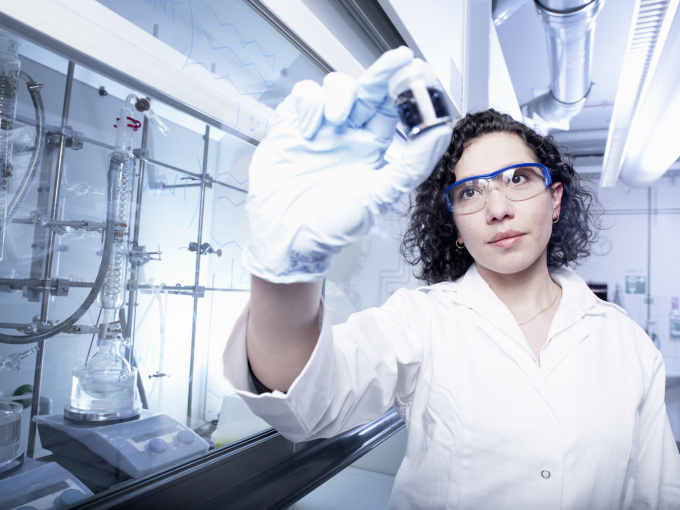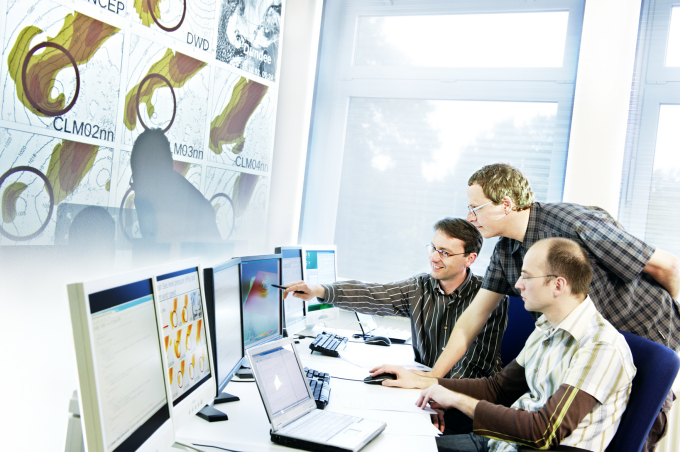The GKSS is giving itself a new name
From the 1st of November, the centre will be known as the Helmholtz-Zentrum Geesthacht Zentrum für Material und Küstenforschung GmbH (Centre for Materials and Coastal Research). The new name intends to show the connection with the Helmholtz Association of German Research Centres and the city of Geesthacht. The addition of the two conceptual pillars of material research and coastal research also outline the current research issues.

Material testing is essential for new materials. It is important to know how much stress a material can withstand before it fails and this starts in a very small measuring range. In the nano-testing laboratory, displacements in the atomic range are generated. With the electron microscope, the structure is displayed at a size a hundred times smaller than a hair. Photo: HZG/ Christian Schmid
“With our new name, we are making it clear what we stand for, from the very first address,” says the scientific director, Prof. Dr. Wolfgang Kaysser. “Because we have been well positioned in the field of material research and coastal research for several years already, not just with the new name.”
The scientists in Geesthacht and at the Teltow site research high-performance materials for the automobiles and aircraft of tomorrow and for implants in regenerative medicine. Their materials will be used for environmentally-friendly technologies, for example as membranes for biogas treatment or for the storage of environmentally-friendly hydrogen.
The costal research department deals with issues concerning the status and changes of the coastal regions and develops, on the strength of this, the basis for future coastal zone management. Furthermore, Geesthacht-based scientists are carrying out research and consultation tasks regarding the climate until 2100.
“The Helmholtz-Zentrum Geesthacht is of outstanding significance for Schleswig-Holstein as a location of scientific research,” said Minister of Science Jost de Jager on the occasion of the name change. “The largest non-academic research facility in the state has a high level of competence and expertise and is closely linked to a network including partners in universities and other research facilities in the state,” emphasised de Jager.
The new Logo

A new design is linked with the name change. This can be most clearly seen on the new logo. The elements in black and blue symbolise the creation of a unit out of their collective order and interaction, which is more than the sum of its individual parts. They represent water and the climate for the coast, the different materials from metals through to organic materials and biomaterials.
Materials Research and Coastal Research: the two major Issues of the Helmholtz-Zentrum Geesthacht

The researchers are developing polymers with completely new properties. For example, modern plastics make vehicles lighter, can be used as tailor-made membranes to separate different substances and can even be used as implants in regenerative medicine. Photo: HZG/ Christian Schmid
The field of material systems deals, for example, with magnesium and titanium aluminide, i.e. materials with a high potential for the light-weight construction much lighter automobiles and aircraft. These materials will not only help to save energy, they will also be essential if we want to continue to drive cars or fly off somewhere on holiday. The Geesthacht-based researchers are working on innovative membranes to reduce CO2 emissions from today’s power stations and they are investigating how hydrogen can be exploited as an environmentally-friendly energy carrier of the future.
The scientists in Teltow are researching implants, for example, which fulfil several functions at the same time. These are inserted into the body and not only replace body parts, which are damaged or injured but also stimulate the human body to regenerate these body parts in the correct position and with all their functions. In this way, the implant is used only as a temporary replacement. The body part grows back and, at the same time, the implant dissolves. One of these wonder materials is “intelligent plastics” with shape memory effect. These innovative biomaterials make innovative regenerative treatment in medicine possible.
The coastal researchers have the task of understanding the climate and coasts as they change and prepare this knowledge for society. In order to expand the expertise in this field, a new sub-institute for biogeochemistry is currently being built up which will explain the important material flows in the offshore marginal seas. Today and more so in the coming years, the COSYNA coastal observation system and knowledge transfer by the Climate Service Center and the Norddeutsche Klimabüro will become central components of HZG research and impartation.

An essential competence of the coastal researchers in Geesthacht is the data evaluation, analysis and modelling of winds, waves and currents to estimate future climate developments. Photo: HZG/ Christian Schmid
As has been the case for many years, the Helmholtz-Zentrum Geesthacht poses important topical and future-oriented scientific, economical and social questions. For example, the involvement of large-scale equipment is being further developed. The centre operates a total of seven beam lines at the FRMII in Munich and at the DESY in Hamburg. The spectrum of complex scientific material issues can be investigated superbly using such equipment.
The Geesthacht-based researchers will also continue to invest in research platforms and networks in a targeted manner. For material research, the scientists operate the Magnesium Innovation Centre (MagIC), the Assessment, Computing und Engineering Centre (ACE), the Centre of Biomaterial Development and the German Engineering Materials Science Center (GEMS).
In terms of coastal research, the scientists are firmly committed to national and international networks, such as the Hamburg Cluster of Excellence CLiSAP and the Baltic Sea Experiment (BALTEX). In the future, the COSYNA coastal observation system and impartation of knowledge through the Climate Service Center and the Norddeutsche Klimabüro will continue to be central components.
Contact

Head of Press Department
Helmholtz-Zentrum Geesthacht - Zentrum für Material- und Küstenforschung
Phone: +49 (0)4152 87-1677
Max-Planck-Straße 1
21502 Geesthacht
